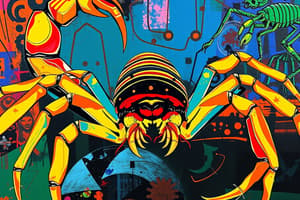Podcast
Questions and Answers
What is the primary mouthpart type found in insects?
What is the primary mouthpart type found in insects?
- Piercing-sucking
- Mandibulate (correct)
- Sponging
- Chelicerate
How many pairs of legs do mites have as adults?
How many pairs of legs do mites have as adults?
- 6
- 8 (correct)
- 4
- 3
Which body region is not present in mites?
Which body region is not present in mites?
- Head
- Abdomen
- Thorax (correct)
- Cephalothorax
What type of eyes might be present in mites?
What type of eyes might be present in mites?
What is a characteristic feature of the body structure of insects?
What is a characteristic feature of the body structure of insects?
Which of the following correctly describes the body structure of organisms in the subphylum Chelicerata?
Which of the following correctly describes the body structure of organisms in the subphylum Chelicerata?
What is a distinguishing characteristic of the class Arachnida?
What is a distinguishing characteristic of the class Arachnida?
Which of the following statements about the class Insecta is true?
Which of the following statements about the class Insecta is true?
What distinguishes the class Chilopoda from the class Diplopoda?
What distinguishes the class Chilopoda from the class Diplopoda?
Which of the following correctly identifies a feature of Class Crustacea?
Which of the following correctly identifies a feature of Class Crustacea?
Study Notes
Key Features of Arthropoda
- Sclerotized exoskeleton composed of chitin, a nitrogenous polysaccharide.
Subphyla of Arthropoda
-
Chelicerata:
- Body segmented into cephalothorax and abdomen.
- Possess 6 pairs of appendages: chelicerae (first pair), pedipalps (second pair), and 4 pairs locomotor appendages.
- No antennae present (includes spiders, mites, ticks, scorpions, crabs).
-
Mandibulata:
- Distinct head separate from thorax.
- Equipped with mandibles for cutting and grinding.
- Typically have 1 or 2 antennae and several pairs of mouthparts (includes insects, millipedes, centipedes).
Classes Within Arthropoda
-
Class Arachnida:
- Body divided into prosoma (cephalothorax) and opisthosoma (abdomen).
- Prosoma contains chelicerae, pedipalps, and 4 pairs of legs; lacks antennae.
- Opisthosoma has no locomotor appendages.
-
Class Crustacea:
- Varied body regions with an unsegmented carapace covering the head and thorax; distinctly segmented abdomen.
- Biramous appendages and compound eyes on stalks.
- Head features 2 pairs of antennae, mandibles, and 2 pairs of maxillae.
-
Class Chilopoda (Centipedes):
- Exhibits distinct external segmentation.
- Composed of head and trunk, with trunk segments each having 1 pair of legs.
- First trunk segment has poison claws resembling mouthparts.
-
Class Diplopoda (Millipedes):
- Clear external segmentation with a distinct head.
- Thorax poorly differentiated from head; consists of fused body segments resulting in 2 pairs of legs per segment.
-
Class Insecta:
- Divided into head, thorax, and abdomen with 3 pairs of legs and 1 or 2 pairs of wings.
- Contains segmented antennae and features simple and compound eyes.
Distinctions Between Insects and Mites
-
Insects:
- 3 body regions: head, thorax, abdomen.
- 6 legs (3 pairs), mandibles for feeding, 2 pairs of wings or none.
-
Mites:
- 2 body regions: cephalothorax and abdomen.
- 8 legs (4 pairs) as adults; larvae possess 6 legs. Chelicerate mouthparts.
General Structure of Insects
- Bilaterally symmetrical; body divided into head (with compound and simple eyes), thorax (with 3 segments and locomotor capabilities), and abdomen (typically 11 segments, lacking legs).
Head Orientation Types in Insects
- Hypognathous: Mouthparts directed ventrally (e.g., grasshoppers).
- Prognathous: Mouthparts oriented forward (e.g., carabid beetles).
- Opisthognathous: Mouthparts positioned posteriorly (e.g., cicadas).
Vision in Insects
- Compound eyes consist of multiple facets, providing mosaic vision.
- Ocelli adapted for detecting light intensity; positioned triangularly between compound eyes.
- Insects can readily distinguish blue and yellow but are unable to perceive red light.
Antennae Functions and Types
- Antennae are sensory organs for touch, smell, humidity detection, and hearing.
- Types of antennae:
- Setaceous, filiform, moniliform, serrate, clavate, capitulate, lamellate, flabellate, pectinate, plumose, bipectinate, geniculate, aristate, and stylate.
Mouthparts Structure in Insects
- Generalized mouthparts consist of labrum, mandibles, maxillae, labium, and hypopharynx; adapted for various feeding habits.
- Labrum: Upper lip with sclerotized structure.
- Mandibles: Powerful jaws moving laterally for chewing.
- Maxillae: Paired structures that assist in food manipulation, with a cardo and stipes supported by segmented palps.
Studying That Suits You
Use AI to generate personalized quizzes and flashcards to suit your learning preferences.
Related Documents
Description
Test your knowledge on the phylum Arthropoda, focusing on its two main subphyla: Chelicerata and Mandibulata. This quiz covers their characteristics, anatomy, and distinguishing features. Perfect for biology students and enthusiasts looking to deepen their understanding of arthropods.




